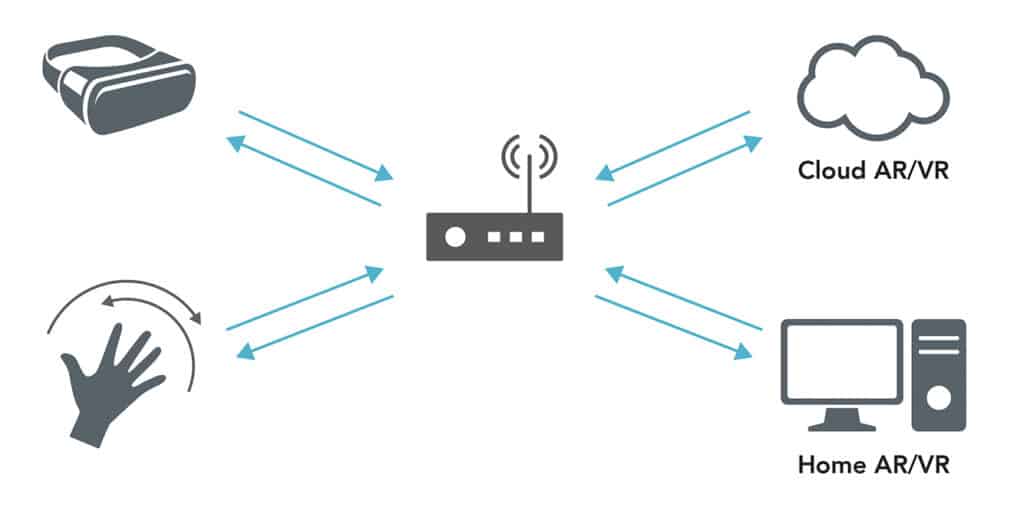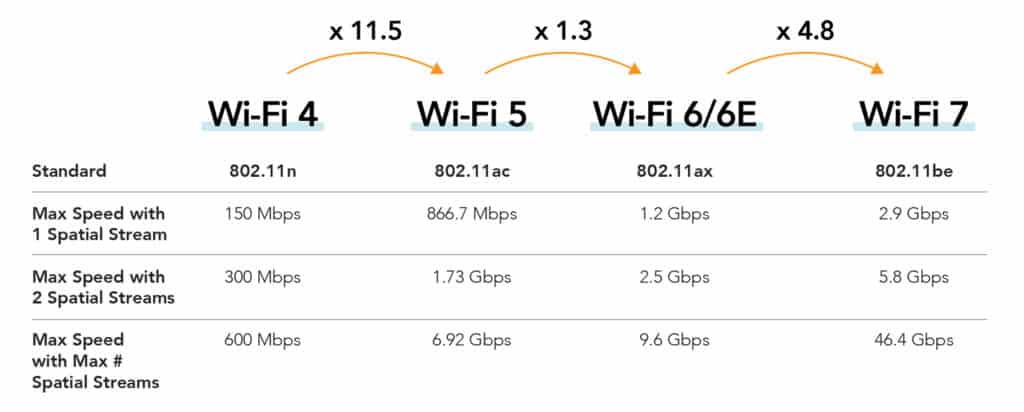Wi-Fi 7: Wi-Fi’s Plaid Mode
By Eve Danel
March 2, 2022
With the 802.11be standard (a.k.a Wi-Fi 7), Wi-Fi has gone to plaid! As hinted at by its name, the IEEE 802.11be EHT “Extremely High Throughput” standard is primarily aiming to provide super-fast data rates for the next generation Wi-Fi 7 devices. The IEEE’s Project Authorization Request(1) (PAR) document sets the impressive goal of supporting a maximum throughput of at least 30 Gbps while improving worst case latency and jitter. These performance objectives are driven by the demands of next generation applications such as high-definition video, industrial automation, immersive experiences, and gaming. To power this WLAN (r)evolution and address future innovative use cases, the 802.11be standard relies on the physical layer (PHY) with key enhancements and new features such as doubling the channel size and increasing the modulation order.
In this blog, we will examine the applications driving the next generation Wi-Fi and their performance requirements as well as the key PHY changes necessary to meet the target performance objectives set by the 802.11be standard.
What drives the need for speed?
With Wi-Fi 6 and 6E high-performance access points and client devices just rolling out, one can wonder why even higher performance is needed. But it is anticipated that by the time Wi-Fi 7 reaches maturity, emerging applications in the Extended Reality (XR) sphere will drive the need for even higher throughput. Uses cases in Augmented Reality, Mixed Reality and Virtual Reality fall under the XR umbrella and encompass fields as diverse as gaming, industrial, health care and enterprise settings. High throughput content delivery is required to ensure excellent user experience and drive adoption of these new applications, but more importantly key performance indicators like latency, jitter and reliability play a critical role to guarantee the sense of reality, and interactivity necessary for the highest user experience.
- High-resolution video is necessary for immersive user experience. Today’s 4K video (4096 x 2160 pixels) requires 20 to 40 Mbps throughput and 8K (7680 x 4320 pixels) content (four times the resolution of 4K) will require 80 to over 100 Mbps.
- Video resolution is not the only driver for higher throughput, other parameters like higher frame rate (> 90 FPS), High Dynamic Range (HDR), stereoscopic video (separate video stream for left and right eye) and 6 Degrees of Freedom (DoF) motion drive these requirements even further. It is expected that 200 Mbps to 5 Gbps (2) are necessary for a rich immersive video experience.
- The data rates requirements are even higher for uncompressed/raw video or lightly compressed video (> 30 Gbps). Uncompressed or lightly compressed content provides reduced processing latency at the end points but at the cost of higher data rates needed for transport.

Figure 1: End to end latency
- Low latency is critical for interactions during game play, or for mission critical applications like industrial robotics operations or medical procedures. This type of application requires real-time exchanges where the data provided in response to the user’s action must be delivered immediately. The system’s feedback needs to be optimized for human reaction time depending on the senses that are used. For example, the Motion to Photon (MTP) latency between head motion and display should remain < 20 ms (2) for user comfort. The delay on the air interface is only a part of the end-to-end latency and the requirements will be driven by the type of application.
A look at Wi-Fi’s speed evolution
The IEEE’s 802.11be target performance of reaching a throughput of at least 30 Gbps may seem ambitious but looking back at Wi-Fi’s generational evolution of the past 20 years, the most striking progress is the pace at which the top data rates have increased. Thanks to a mix of technological advances and breakthrough new features, each generation has delivered higher performance than its predecessor.

Figure 2: Wi-Fi generational speed evolution
The current generation of Wi-Fi 6 devices is based on the 802.11ax standard. At its inception, in 2014, the High Efficiency WLAN (HEW) 802.11ax standard was directed at improving spectrum efficiency and performance in dense networks. This goal was a departure from previous Wi-Fi generations that had mostly focused on throughput enhancements. Via innovative features most notably Uplink and Downlink OFDMA and MU-MIMO, in dense environments Wi-Fi 6 devices can achieve an average per-user throughput improvement of 4 times over Wi-Fi 5.
Furthermore, with the expansion of Wi-Fi in the 6 GHz band, Wi-Fi 6E devices can now benefit of up to 1200 MHz of uncongested spectrum. This additional spectrum opens the door to numerous new channels and enough contiguous spectrum to support the creation of extra wide 320 MHz channels. This is why, with the 802.11be standard, the focus is once again on delivering even higher throughput for Wi-Fi users with top speed up to 4.8 times faster than Wi-Fi 6/6E.

Figure 3: WiFi 6/6E and Wi-Fi 7 Speed Comparison for 2 Spatial Stream devices.
Wi-Fi 7 can reach a top link speed of 46 Gbps with 16 spatial streams and maximum 320 MHz channel bandwidth. For typical clients with 2 spatial streams, the highest data rate is around 5.8 Gbps on a single link, 2.5 times higher than similar 802.11ax clients.
What powers the Wi-Fi speed evolution?
Wi-Fi’s link speed evolution is powered by PHY technological enhancements along 3 dimensions:
- Modulation Order (QAM)
- Channel Size
- Number of Spatial Streams

Figure 4: Wi-Fi PHY generational evolution
Modulation Order
Wi-Fi uses Quadrature Amplitude Modulation (QAM) for efficient data encoding. With each new Wi-Fi generation, higher data rates are achieved by encoding more data bits per symbol. Higher-order QAM enables to transmit more data bits while maintaining the same spectrum footprint and therefore achieve better efficiency.
- 802.11ac (Wi-Fi 5) supports up to 256-QAM where 8 bits of data are encoded per symbol
- 802.11ax (Wi-Fi 6/6E) supports up to 1024-QAM, where 10 bits of data are encoded per symbol
- 802.11be introduces 4096-QAM modulation with 12 bits of data per symbol
4096-QAM leads to an increased data rate of 20% over 1024-QAM.
Channel Size
By doubling Wi-Fi’s channel bandwidth, nearly twice the amount of data can be carried in a single transmission. The 802.11be standard defines operation in the 6 GHz band, with a channel plan currently defined for up to 6 overlapping 320 MHz channels. The availability of 1200 MHz contiguous spectrum in the 6 GHz band has opened the door to doubling the channel bandwidth from 160 MHz (maximum bandwidth in 802.11ax) to 320 MHz channels, hence doubling the maximum throughput. Availability of the 6 GHz band is however subject to regulatory approval and not all worldwide regions can enjoy the same amount of spectrum. The 5 GHz and 2.4 GHz bands cannot support 320 MHz channels, therefore this Wi-Fi 7 feature will be accessible to only a subset of users.
Spatial Streams
Spatial streams increase the system’s throughput by transmitting independent data streams on multiple antennas simultaneously. Therefore, the maximum throughput of a system with 8 spatial streams is 8 times that of a system with a single antenna. The 802.11ax standard defined MIMO support up to 8 spatial streams and this capability is already supported by some AP chipsets. The 802.11be generation could support up to 16×16 in the future, and thus doubling the maximum throughput compared to 802.11ax. While the theoretical maximum throughput can only be achieved between devices with the same antenna count, the number of MIMO streams for Client Stations is typically limited to 2 or 3. The high number of spatial streams is an important factor for increased spectral efficiency with the implementation of Multi-User-MIMO (MU-MIMO), another feature supported in the 802.11be standard.
Multi-Link Operation
Multi-Link Operation (MLO), a breakthrough feature defined in the 802.11be standard adds a new dimension to Wi-Fi’s link speed evolution diagram.

Figure 5: 802.11be Multi-Link Operation
With a common MAC layer and separate PHY layers, Wi-Fi 7 Access Points and Client Stations are capable of transmitting and receiving simultaneously on multiple links. In the hypothetical case of an AP Multi-Link Device (MLD) operating at 320 MHz channel in the 6 GHz band and 160 MHz channel in the 5 GHz band connected to a dual-radio MLD Client (2×2 + 2×2), the throughput could reach up to 8.6 Gbps by having data transmitted simultaneously on both links and thereby reducing latency. By taking advantage of intelligent traffic scheduling and prioritization, MLO enables reduced latency(3) and jitter by prioritizing data transmission on links with the best RF conditions or improve reliability by duplicating data on multiple links.
Conclusion
While Wi-Fi 6 and Wi-Fi 6E high devices are well positioned for the needs of today’s applications, by the time Wi-Fi 7 reaches maturity it is anticipated that the consumer, enterprise, and industrial spaces will be upended with new applications requiring content delivery with extremely high throughput, low latency, low jitter and high reliability. The 802.11be standard is being defined to serve these applications so that Wi-Fi 7 can become the main connectivity technology capable of delivering the highest user experience. Wi-Fi device’s RF PHY performance is the critical foundation that will unlock this potential.
For more information visit the IQxel-MX page to learn about LitePoint’s test solutions for 802.11be or watch a replay of our webinar on Wi-Fi 7.
References:
1: https://standards.ieee.org/ieee/802.11be/7516/
2: https://www.qualcomm.com/media/documents/files/vr-and-ar-pushing-connectivity-limits.pdf
3: https://www.qualcomm.com/news/onq/2022/02/14/pushing-limits-wi-fi-performance-wi-fi-7
Categories
Subscribe to the LitePoint Blog
Related Posts


